Bill Blass, 79; Defined American Style
Bill Blass, the designer who in his 50-year career helped define a distinctly American style of fashion, died Wednesday night at his home in New Preston, Conn. He was 79.
Blass’ death was confirmed by friend Helen O’Hagan, who said he died of cancer.
Although Blass had the manners and poise of Cary Grant, dressed like an English gentleman and spoke with an upper-class accent of indeterminate origin, he was born in Fort Wayne, Ind., the son of a hardware store owner. If he wasn’t an aristocrat by birth, he understood how those who were wanted to dress: in flattering, classic clothing that was neither too flashy nor avant-garde. Before Blass and a few other innovators capitalized on American women’s ability to make sporty clothes look dashing, a more formal, fussy style, dictated by Paris designers, ruled international fashion.
His role in New York society was as precedent-setting as his designs. Before Blass, designers were unknown hired hands who would literally and figuratively use the back door. He was the first “dressmaker” to be accepted into the same caste as his clients, and his social ascent changed the status of ambitious designers, paving the way for the era of the designer as celebrity, when Ralph Lauren, Calvin Klein and Donna Karan became superstars whose sales benefited from their carefully marketed images.
Why Blass?
“He was special,” said Michael Groveman, who ran Blass’ company for more than a decade. “He walked into a room, and he filled it up.”
When Blass came to New York in 1939, his idea of fashion was inspired by the glamorous lives he had seen portrayed in Hollywood films of the Depression by stars such as Carole Lombard and Constance Bennett. The New York garment district was a rough neighborhood then, but he didn’t lose sight of the images of stylish women that initially drew him to fashion. Before long, he got to know the real-life counterparts of Hollywood’s sophisticates, and demonstrated a knack for creating clothes they wanted to wear.
In a memoir published in the New Yorker magazine in 1997, Blass wrote that, before World War II, “the city was the most extraordinary place to see wonderfully dressed women. Everybody dressed up. You put on clothes for lunch, clothes for cocktails, clothes for dinner, whereas today you go to work, lunch and dinner in the same ... black pantsuit.”
As women’s wardrobes changed, Blass adapted. Yet he never stopped offering proper suits for day and dazzling evening gowns. He was so inventive that often younger designers would discover a look--a cashmere sweater and ball-gown skirt as a relaxed alternative to an evening dress, for example--only to realize that Blass had done it 30 years earlier. Camel’s hair polo coats, peacoats and striped sailor’s T-shirts, the sort of garments that Ralph Lauren later made staples of his collections, were first elevated by Blass. He remade these preppy basics in luxurious fabrics, or combined them with more elegant pieces, before the juxtaposition of opposites was an accepted fashion idiom.
After beginning his career as a sketcher, the designer served in the Army for three years, then returned to an industry still heavily influenced by European fashion. Yet, he realized, “American women have a way of wearing clothes which doesn’t date them. The best-dressed ones have had a sense of themselves which didn’t depend in the least on what the world was wearing. And so it came to me that there could be a way of designing for women that was, in the best sense, American.”
According to Blass, “A certain nonchalance is always a constant in American clothes .... Having the confidence to mix things up is very American.” He applauded women who wore his tailored jackets over Gap T-shirts, tucked into Banana Republic trousers.
He called his loyal followers “gals,” and his clients, who included Nancy Reagan, Barbara Bush, Barbara Walters and the late Katharine Graham and Pamela Harriman, became friends. Although he made several attempts at marketing moderately priced lines, his forte was expensive clothing (a suit would cost $3,500), for a group often described as “the ladies who lunch.” If he addressed one of them as “babe,” or “kid,” it wasn’t because he couldn’t remember names, but because he liked the sound of it. And so did they.
A sought-after escort, Blass knew the tastes and preferences of his affluent clientele because he was a guest in their homes and attended their charity benefits. For all his social dexterity, he acknowledged he didn’t relate well to people on a personal level, and details of his private life were kept secret.
Louise Grunwald, wife of former U.S. Ambassador and Time Magazine editor Henry Grunwald, a Blass client and friend, said, “Bill was very winning, but in a wry and ironic, not a saccharine way. That shouldn’t sell dresses, but somehow it does. He’s a man who wears well in many different situations, with a wide range of interests--he probably read three books a week. He was very talented, and understood American women and that they like to look pretty, and I’m not sure that a lot of designers get that today. His clothes were truly timeless. I wish I’d held onto some Blass things I had 25 years ago, because they’d still look wonderful.”
In the 1950s, Blass became known as a designer for Maurice Rentner. He was one of the first American designers to have his name on a label--Bill Blass for Maurice Rentner, initially. When he bought the company in 1970, changing its name to Bill Blass, it was rare for a designer to own his own firm. He proved to be a shrewd businessman, breaking new ground in exploring the lucrative world of licensing, putting his name on everything from menswear to home furnishings.
A menswear line introduced in 1967 was hugely successful, in part because men wanted to dress like him. “His personal style was so remarkable,” said Los Angeles socialite Nancy Vreeland, who worked with Blass from 1966 until the early ‘70s. “He very much respected and patterned himself after the Duke of Windsor. He brought a keen appreciation of masculine tailoring and fabrics to his women’s clothes, yet gave them tremendous femininity.”
As Blass’ name and image became better known, he was even in demand to design automobile interiors, which he did for Lincoln in the ‘70s. And he was the first designer to have his name on chocolates, in the ‘80s. He pioneered appearances in department and specialty stores, where he proved to be a master salesman--a single visit to a Saks Fifth Avenue branch could bring in $700,000 or more. By making regular road trips, he became familiar with the wardrobe needs of women in cities like St. Louis and Cincinnati. He wasn’t always the darling of fashion magazines, but Blass’ gals, throughout the country, were loyal.
“Those trips taught me about what works and doesn’t work in different parts of the country,” Blass wrote in his New Yorker memoir. “Black, of course, was a New York invention. But in bright, sunny cities like Houston and Los Angeles, black looks terrible. I always say to women that when you’re out at night and in a sea of men in dark suits, wear red or white and you’ll be noticed.”
A founding member of the Council of Fashion Designers of America and the trade organization’s honorary president from 1979 to 1981, Blass received the group’s lifetime achievement award in 1997 and a special award as the Dean of American Fashion in June 2000. He was the first recipient of a CFDA award for humanitarianism, which recognized his support of AIDS research and other charities. In 1994, the Bill Blass Public Reading Room was dedicated, to commemorate his $10-million endowment to the New York Public Library.
Blass suffered a minor stroke in December 1998, while at a Saks Fifth Avenue store in Houston. He retired after his Spring 2000 collection was presented in September 1999. Groveman, who had been chief financial officer, bought the $700-million-a-year company.
A diagnosis of tongue cancer early in 2000 made it difficult for Blass to remain as involved with the company as he had intended when he gave up full-time designing chores, but by the end of the year, he was feeling strong enough to work part time.






